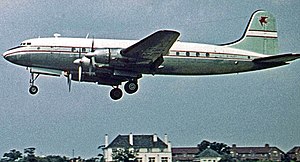Handley Page Hermes
| HP.81 Hermes | |
|---|---|
 |
|
| Hermes IV of Air Safaris at Manchester Airport in 1961 | |
| Role | Airliner |
| Manufacturer | Handley Page |
| First flight | 2 December 1945 |
| Introduction | 6 August 1950 |
| Primary user | BOAC |
| Produced | 1945–1951 |
| Number built | 29 |
| Developed from | Handley Page Hastings |
The Handley Page HP.81 Hermes was a British civilian airliner built by Handley Page in the 1940s and 1950s. Closely related to Handley Page's Hastings military transport, the Hermes was a low-wing monoplane powered by four piston engines. Twenty-nine were built, serving briefly with BOAC in the early 1950s and later with several charter airlines.
The Hermes was built to meet the 1944 Air Ministry specification for a pressurised civil transport capable of carrying 34 first-class or 50 tourist-class passengers, at the same time as the RAF required a new transport to replace its Handley Page Halifax, for which Handley Page designed the very similar Handley Page Hastings. Unlike the tailwheel Hastings, the Hermes was planned to have a nosewheel undercarriage, although the first two prototypes used a tailwheel undercarriage, of which the first was an unpressurised "bare shell" and the second to be pressurised and fully equipped. It was intended to introduce the Hermes before the Hastings, but production was delayed after the first prototype (HP 68 Hermes 1), registered G-AGSS crashed on its maiden flight shortly after takeoff on 2 December 1945. Handley Page's chief test pilot and the chief test observer were both killed. Development of the civil Hermes was delayed to resolve the instability that caused the accident to the first prototype, and the chance was taken to lengthen the second prototype, producing the HP 74 Hermes II (G-AGUB), first flying on 2 September 1947.
Meanwhile, orders were placed on 4 February 1947 for 25 of the definitive HP 81 Hermes IV, fitted with a tricycle undercarriage and powered by 2,100 hp (1,570 kW) Bristol Hercules 763 engines, for BOAC and two HP Hermes V, powered by the Bristol Theseus turboprop engines.
While the first Hermes IV (registered G-AKFP) flew on 5 September 1948, and production built up quickly, the early aircraft were overweight, partly due to the use of Hastings components, and were initially rejected by BOAC.
...
Wikipedia
